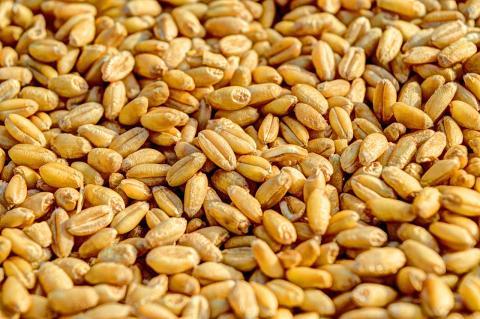
Wheat berries are the true whole wheat. They are the complete grain that contains the bran, germ and endosperm. They can be grown into wheat grass, ground into flour or used as side dishes and in salads. They are rich in nutrients, making wheat berries a superfood that benefits the entire body. Wheat berries have several varieties; the Hard Red Spring and Hard Red Winter have a brown tint and are high in protein. They are primarily used to make flour for breads. The Hard White variety is hard with a pale color and is used for brewing and making bread; the Soft White is also pale in color with a soft kernel and is used to make pastry flour. Wheat berries are so rich in vitamins, minerals and proteins that a family of four can live on wheat berries and products made from this whole kernel for ten years on wheat grown in one acre of land. The wheat berry is the kernel of the wheat or the wheat seed and there are approximately fifty kernels per wheat head and 15,000 to 17,000 wheat berries in one pound.
Wheat is an ancient grain originating in Asia and was brought to America with Columbus on his second voyage. Though introduced in the initial invasion of America, wheat did not become a significant cultivated crop until the late 19th century. It is a hardy plant that can be grown in harsh environments and can be found in countries throughout the world. It is mainly ground into flour for breads and pastries but the whole kernel, also known as wheat berries, are used to make cereals, fillers for meat products and as a substitute for beans in chili. They are an excellent food for vegetarians because of their high protein content and versatility in preparing substitute meat dishes like veggie burgers and vegetarian meatloaf. Wheat berries can be ground at home to make flour for baking or can be cultivated in the kitchen to grow wheat grass.
A serving of one-half cup of cooked wheat berries contains 111 calories, 3.5 grams of protein, 24.9 grams of carbohydrates and 4.3 grams of fiber. It also has .5 grams of fat and 3 milligrams of sodium and is cholesterol free. Some of the vitamins and minerals in wheat berries are B-vitamins, vitamin E, folate, potassium, iron, calcium and trace minerals. This makes wheat berries a beneficial addition to the diet.
Here are 5 more reasons to eat more wheat berries:
1. Eating organic wheat berries helps to reduce the risk of cardiovascular diseases by lowering cholesterol levels. They are rich in omega-3 fats, which also helps to reduce the incidence of high blood pressure. Because they are a whole grain, wheat berries are effective in regulating the metabolism.
2. Wheat berries are an excellent food to reduce the effects and lessen the risk of type-2 diabetes. They have a high content of magnesium, acting as a catalyst for more than 300 enzymes. This means that wheat berries help to balance the body’s use of insulin and the secretion of glucose. Those who have type-2 diabetes can control their blood sugar levels by replacing rice with wheat berries.
3. The risk of gallstones can be lessened or eliminated completely in women by adding wheat berries to their diet. Rich in soluble fiber, wheat berries increase the movement of the bowels and thus reduce the secretion of bile acids. (A major cause of gallstones is excessive secretion of bile acids.)
4. Wheat berries are also good for women experiencing pre-menopausal or menopausal symptoms. The grain is rich in lignans that are found in the body’s hormone receptors. It regulates the secretion of estrogen, controlling mood swings, hot flashes, and other problems.
5. As a cancer preventative, wheat berries are high in fiber, which has been found to be a deterrent for the development of breast cancer. Wheat berries are also a good food to add to children’s diets because they lower the risk of children developing asthma.
Wheat berries are the true whole wheat that are rich in nutrients and are a versatile grain. They have been used to heal and maintain health, and modern healers use them in their arsenal of food cures. They can be ground into flour, sprouted, cooked as cereals, prepared as side dishes and used for vegan protein foods. When stored in the freezer, wheat berries can stay fresh for about a year.








